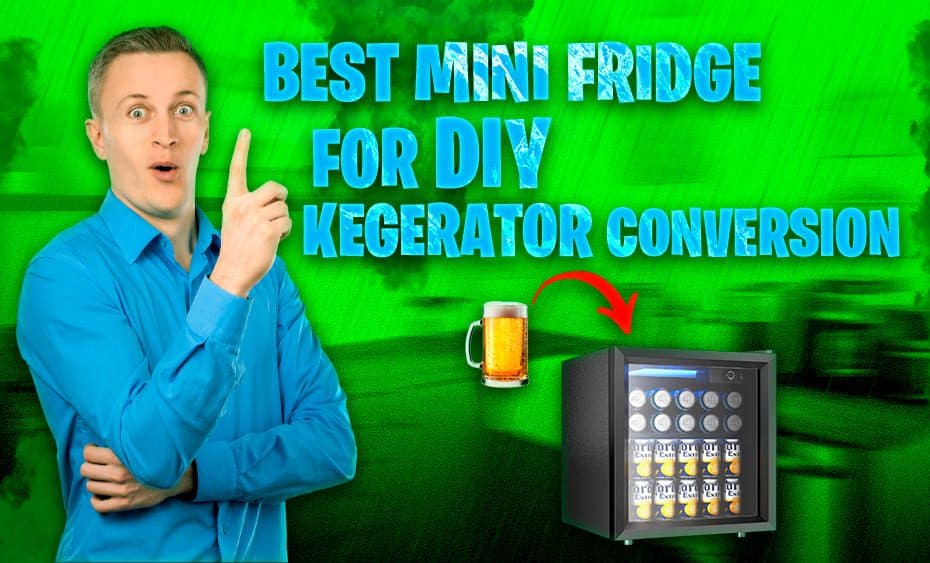For craft beer enthusiasts, there’s nothing quite like the satisfaction of pouring a perfectly chilled, perfectly carbonated pint from your own kegerator. But traditional kegerators can be bulky, expensive, and leave limited space for the ever-growing collection of delicious brews. For that reason, many are looking for a DIY mini fridge kegerator solution that transforms your trusty mini fridge into a personal draft haven. However, with so many options for mini fridges, selecting the ideal candidate for your DIY kegerator project can feel like navigating a labyrinth.
Before you grab the nearest screwdriver and mini fridge, there are some challenges to consider. Here are a few potential hurdles to navigate:
- Size Constraints: Mini fridges vary in size, and finding one that can comfortably house a keg and a CO2 tank is crucial. Space for a kegerator tower and tap also needs to be factored in.
- Power Consumption: Keg systems require consistent cooling, so choosing a mini fridge with sufficient power (amps) to handle the load is essential. As long as the mini fridge’s amperage is below 15 amps, it should be safe to use on a standard outlet.
What is amperage? Amps (amperage) measure the flow of electricity, like the rate of water flowing through a pipe. Higher amps mean more electricity flowing. It’s important for mini fridges because power strips have a limit on how much current they can handle safely. Using a dedicated wall outlet ensures your mini fridge gets the power it needs without overloading anything.
- Modification Considerations: Some mini fridges may require minor modifications to accommodate kegerator components, like drilling a hole for the tap line. Ensure you’re comfortable with basic DIY tasks.
While the conversion itself might seem straightforward, remember there are a few hurdles to jump before you crack open a cold one from your homemade kegerator. From ensuring your mini fridge has enough space for all the components to considering any minor modifications it might need, a little planning goes a long way in creating your dream kegerator setup.
Choosing the Perfect Mini Fridge: Size Matters
The key to a successful mini fridge kegerator conversion lies in selecting the right fridge. Here’s what you need to consider:
Internal Dimensions: Measure the interior height, width, and depth of your chosen mini fridge. Remember, you’ll need space for a keg, a CO2 tank, and potentially a kegerator tower:
- Standard 6th Keg Compatibility: Many DIY enthusiasts aim for a mini fridge that can comfortably fit a standard 6th size keg (typically 5 gallons). These kegs are a good balance between size and beer variety.
- Consider Slim Kegs: If space is extremely limited, explore “slim kegs” (typically 3.6 gallons) as an option.
- Vertical vs. Horizontal Storage: Some mini fridges allow for vertical keg storage, while others might be better suited for horizontal placement. Choose based on your available space and keg size.
Power Consumption: Check the mini fridge’s amperage rating (amps) and ensure it’s sufficient for running the compressor consistently. A typical mini fridge might draw between 1-3 amps, but some larger models or kegerator kits might require more.
Ease of Modification: Ideally, choose a mini fridge with a user-friendly design for drilling a tap line hole. Look for fridges with easily accessible back panels or removable shelves.
Best Mini Fridges For a DIY Kegerator
Here are some popular mini fridge choices for DIY kegerator conversions, keeping in mind that availability and specific models may vary:
- GE 3.1 cu. ft. Compact Refrigerator (GTM3100ARAR): This GE fridge is ideal for slim kegs, making it a space-saving solution for smaller living areas. It’s a great choice for budget-minded individuals who want to start their DIY kegerator project without breaking the bank.
- Igloo 4.5 cu. ft. Compact Refrigerator (IRKZ45S): This Igloo fridge is a great option for those who want a spacious interior for a standard sixth keg and a CO2 tank, with extra room for leftover beverages. It boasts a sleek stainless steel design and has positive reviews for its energy efficiency.
- Koolatron 4.4 cu. ft. Compact Refrigerator (KRT44S): Suitable for standard 6th kegs, this Koolatron fridge is a great option if you have the space and plan on storing a full-sized keg. It boasts a sleek design and has positive reviews for its quiet operation.
- Black+Decker 3.2 cu. ft. Compact Refrigerator (BC-3.2W): Ideal for slim kegs, this mini fridge is a budget-friendly option for those starting with DIY kegerator projects.
Pro Tip: Research online forums and communities dedicated to DIY kegerator builds. These resources often have user reviews and recommendations for specific mini fridge models.
Pro Tips for Optimal Kegerator Performance
- Temperature Control: Most mini fridges offer limited temperature control options. Aim for a setting around 38°F (3.3°C) for optimal beer serving temperature. Consider using a dedicated thermometer inside your mini fridge to monitor temperature fluctuations.
- Line Length: The length of your beer line can affect pour quality. Ideally, choose a beer line length that minimizes wasted beer during purging and ensures a proper pour. Consult your kegerator kit instructions or online resources for specific recommendations based on your setup.
- Cleaning and Maintenance: Regularly clean your tap and keg system components to prevent clogs and ensure optimal performance. Follow the cleaning instructions provided with your kegerator kit.
- Freshness Matters: While kegerators offer a great way to enjoy draft beer, remember that kegs have a limited shelf life once tapped. Consume the keg within 2-4 weeks for the best quality and taste.
To ensure a perfect pint from your kegerator, keep these final tips in mind: aim for a fridge temperature of 38°F (3.3°C) and monitor it with a thermometer. Choose the right length of beer line to minimize waste and ensure a proper pour (consult your kit instructions). Regular cleaning of the tap and keg system is essential, following the provided instructions. Remember, fresh is best – enjoy your draft beer within 2-4 weeks for optimal taste and quality.
Final Thought: With the right mini fridge and a touch of DIY magic, you’re just a few steps away from enjoying frosty pints from your very own kegerator. Remember, planning is key – consider space constraints, temperature control, and proper cleaning routines. So, grab your tools, choose your favorite fridge from this guide, and get ready to toast to the satisfaction of creating your home draft system. Cheers!

With over 15 years of experience in the appliance industry, I am a passionate advocate for efficient and stylish mini fridges. I specialize in energy-saving models and compact living solutions. As a certified appliance repair technician, I have a deep understanding of mini fridge maintenance and troubleshooting.

